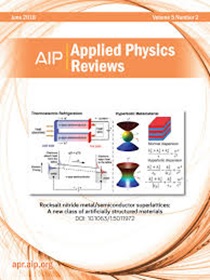紫外/红外双波段光探测和解复用应用,由宽/窄带隙异质结实现
IF 11.6
1区 物理与天体物理
Q1 PHYSICS, APPLIED
引用次数: 0
摘要
宽/窄带隙异质结为开发宽带响应、高速和高灵敏度光电探测器提供了良好的潜力。利用这些探测器的不同光谱响应,可以有效区分不同波长的传输数据,使其成为波分复用以提高光通信传输速率的有希望的候选者。在此,我们提出了一种基于ZnO/PbSe宽/窄带隙异质结的简单双波长解复用策略,利用ZnO的光敏/介电特性以及独特的带向,实现紫外(UV)-红外(IR)宽带检测。该探测器在紫外区表现出连续的光电流响应,而在红外区产生瞬态脉冲光电流。本文首次报道了瞬态光电探测器的响应波长从近红外(NIR)扩展到中红外(MIR)。此外,响应带宽在紫外波段达到2 kHz,在红外波段达到0.7 MHz。紫外/红外双波长光通信测试表明瞬态脉冲和连续光电流共存。通过在输出端加入不同的滤波模块,可以同时提取两个波长的传输数据。该研究为宽带光探测和波长解复用提供了一种简单实用的方法,同时也为将宽带隙半导体应用于红外光电器件提供了一条新的途径。本文章由计算机程序翻译,如有差异,请以英文原文为准。
UV/IR dual-waveband photodetection and demultiplexing applications enabled by a wide-/narrow-bandgap heterojunction
A wide-/narrow-bandgap heterojunction offers promising potential for developing broadband response, high speed, and highly sensitive photodetectors. By exploiting the different spectral response of these detectors, transmitted data of different wavelengths can be effectively distinguished, making them promising candidates for wavelength division multiplexing to enhance optical communication transmission rates. Herein, we present a facile dual-wavelength demultiplexing strategy based on ZnO/PbSe wide-/narrow-bandgap heterojunction to achieve ultraviolet (UV)-infrared (IR) broadband detection by utilizing the photosensitive/dielectric properties of ZnO along with unique band alignment. The detector demonstrates a continuous photocurrent response in the UV region, while producing transient pulsed photocurrent in the IR region. It is first time reporting response wavelength extension of transient photodetectors from near-infrared (NIR) to mid-infrared (MIR). Additionally, the response bandwidth reaches 2 kHz in the UV and 0.7 MHz in the IR bands. The UV/IR dual-wavelength optical communication tests show the coexistence of transient pulsed and continuous photocurrents. By incorporating different filter modules at the output terminals, the transmitted data at both wavelengths can be extracted simultaneously. This study offers a facile and practical approach for broadband photodetection and wavelength demultiplexing, while also providing a novel route for extending the application of wide-bandgap semiconductors to IR optoelectronic devices.
求助全文
通过发布文献求助,成功后即可免费获取论文全文。
去求助
来源期刊

Applied physics reviews
PHYSICS, APPLIED-
CiteScore
22.50
自引率
2.00%
发文量
113
审稿时长
2 months
期刊介绍:
Applied Physics Reviews (APR) is a journal featuring articles on critical topics in experimental or theoretical research in applied physics and applications of physics to other scientific and engineering branches. The publication includes two main types of articles:
Original Research: These articles report on high-quality, novel research studies that are of significant interest to the applied physics community.
Reviews: Review articles in APR can either be authoritative and comprehensive assessments of established areas of applied physics or short, timely reviews of recent advances in established fields or emerging areas of applied physics.
 求助内容:
求助内容: 应助结果提醒方式:
应助结果提醒方式:


